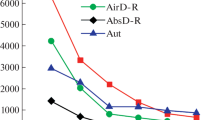Abstract
It is common to consider the experimental soil physics results from the standpoint of a three-phase soil model. Along with the three-phase model, a gel model of soils is used. These models are based on different principles: in the three-phase model, solid phase constancy and liquid mobility; in the gel model, the ability of soil gels to swell, harden, and reduce water mobility. The purpose of this work is to assess the applicability of three-phase and gel soil models to analyzing the study results of some physical properties of soils. The studies were carried out with the zonal soil series: sod–podzolic, gray forest, chernozem, and chestnut soils. The following methods were used in this work: vibration viscometry, laser diffractometry, and electrical resistivity of soils. Unexpected results were obtained in the study of the soil’s physical properties. Firstly, the curve of the relationship between the moisture content of soil samples and the viscosity of pastes prepared from them reached the maximum at the point of limited availability of water (PLAW). Secondly, under the increased mechanical action on soil pastes, the particle size increased rather than decreased in them. Thirdly, the soil electrical resistivity–moisture relationship maintains a uniform course in the PLAW area. Meanwhile, at this water content, the continuous liquid phase framework providing moisture and electrical conductivity disappears in the soils. Fourthly, moist soils dry out in a desiccator over water. It is not possible to explain these results from the standpoint of the three-phase soil model generally accepted in soil science. For this reason, the gel model of soils was used to analyze and explain all the results obtained.




Similar content being viewed by others
Notes
Trapped air in microaggregates apparently does not have the destructive effect that is characteristic of its action on macroaggregates.
REFERENCES
E. V. Shein, Course of Soil Physics (MSU, Moscow, 2005) [in Russian].
A. F. Tyulin, Organomineral Colloids in Soil and Their Genesis and Significance for Root Nutrition of Higher Plants (USSR Acad. Sci., Moscow, 1958) [in Russian].
R. Osterberg and K. Mortensen, Eur. Biophys. J. 21 (3), 163–167 (1992).
E. Yu. Milanovskii, Humic Substances as Natural Hyd-rophobic‑Hydrophilic Compounds (GEOS, Moscow, 2009) [in Russian].
N. Senesi, F. R. Rizzi, P. Dellino, and P. Acquafredda, Physicochem. Eng. Aspects 127 (1–3), 57–68 (1997).
N. Senesi, F. R. Rizzi, P. Dellino, and P. Acquafredda, Soil Sci. Soc. Am. J. 60 (6), 1613–1678 (1996).
G. N. Fedotov and G. V. Dobrovol’skii, Eurasian Soil Sci. 45 (8), 811 (2012).
D. D. Khaidapova, A. V. Mishchenko, and D. V. Karpova, Agrofizika, No. 1, 17‒21 (2022).
G. N. Fedotov, S. A. Shoba, D. A. Ushkova, I. V. Gorepkin, O. A. Salimgareeva, and D. I. Potapov, Dokl. Earth Sci. 511 (1), 614‒618 (2023).
Yu. G. Frolov, Course of Colloid Chemistry (Khimiya, Moscow, 1982) [in Russian].
A. D. Voronin, Structure-Functional Hydrophysics of Soils (MSU, Moscow, 1984) [in Russian].
A. A. Rode, Foundations of Soil Moisture Theory (Gidrometeoizdat, Leningrad, 1965), Vol. 1 [in Russian].
N. V. Obrucheva and O. V. Antipova, Fiziol. Rast. 44 (2), 287‒302 (1997).
Funding
The work was supported by the Russian Science Foundation, project no. 22-14-00107.
Author information
Authors and Affiliations
Corresponding author
Ethics declarations
The authors of this work declare that they have no conflicts of interest.
Additional information
Translated by E. Maslennikova
Publisher’s Note.
Pleiades Publishing remains neutral with regard to jurisdictional claims in published maps and institutional affiliations.
Rights and permissions
About this article
Cite this article
Fedotov, G.N., Shoba, S.A., Ushkova, D.A. et al. Three-Phase and Gel Models of Soils in the Analysis of Experimental Results. Dokl. Earth Sc. 515, 453–457 (2024). https://doi.org/10.1134/S1028334X2360319X
Received:
Revised:
Accepted:
Published:
Issue Date:
DOI: https://doi.org/10.1134/S1028334X2360319X




